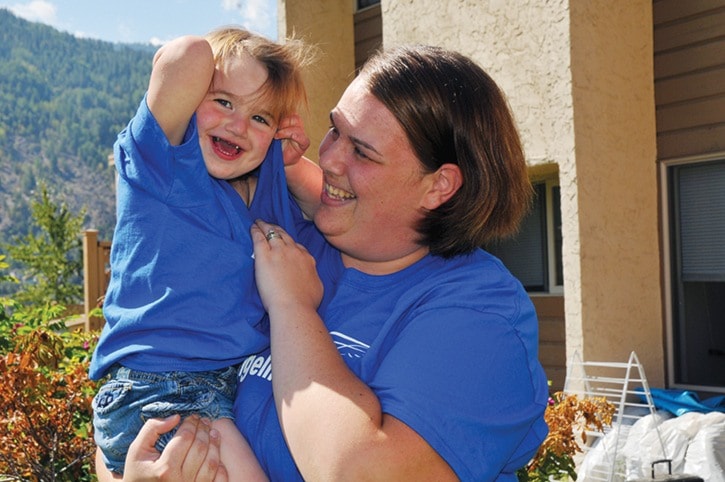Chances are you’ve never heard of the UBE3A gene or Angelman Syndrome (AS).
The Gould family wants to change that following their sweet little girl’s diagnosis.
Fayth Gould is a bubbly Trail toddler who turns three in November. She was born with the chromosomal anomaly, but was only recently determined to be lacking the specific gene which causes AS.
To raise awareness about the condition, her family and friends have organized an all-day bake sale slated for Wednesday, beginning at 10 a.m., in the Waneta Plaza.
Money raised is just icing on the cake, says Fayth’s mom Stacey Gould, adding that all proceeds will go to the Canadian Angelman Syndrome Society.
“We are baking up a storm, and accepting any and all donations,” Stacey added. “Anything will be appreciated. If people want to donate baked goods, canning, or money, they can just drop it off at the mall the morning of the bake sale.”
The syndrome affects about one in 15,000 people, but Fayth is the only known case in the West/East Kootenay.
“To me the awareness of this syndrome is most important,” explained Stacey. “For myself, and just about everyone I have talked to, they had never heard of Angelman Syndrome. Although there is nothing you can do to prevent it from happening, it is something to be aware of. My goal is to spread the word.”
The complex neuro-genetic disorder is rare and often remains hidden until the infant first shows signs of developmental delay at six months. Diagnosis takes several years because unique clinical features, such as severe speech or intellectual impairment, an unusual gait, tremulous limbs and an unusually happy demeanor, may not manifest until the child is one year or older.
That’s exactly what happened before Fayth was diagnosed earlier this year, though maternal intuition told her mom that something was amiss long before.
“I have an older daughter as well,” explained Stacey, mentioning Felicity Gould, 6. “When Fayth was not reaching the same milestones, like sitting unassisted and crawling, it caused red flags to go up.”
Stacey’s pregnancy was textbook, the C-section birth went according to plan, and by all accounts, Fayth was a healthy newborn.
“At six months I started noticing these things,” said Stacey. “I took her to the doctor all the time with my concern, but was always told that kids all develop at their own rate and that they were sure Fayth would catch up.”
The devoted mom persevered along with her husband Barry Gould, because they instinctively knew that something wasn’t right.
She wasn’t “heard” until March 2014, when Stacey described her daughter as “babyish” to Trail’s then-pediatrician Dr. Henry Ukpeh.
“It took some convincing and a lot of pushing with my concerns for things to start rolling,” she said. “I said to Dr. Ukpeh that ‘Fayth seems so babyish,’ and this sent red flags up for him, so he sent us to BC Children’s Hospital in Vancouver.”
For five days Fayth endured a battery of tests. Countless vials of blood were drawn and genetic investigation began, on top of an MRI, a spinal tap, visual screening, and auditory testing.
“Her MRI showed she had microcephaly (a small head) and a decrease in grey matter,” said Stacey. “I was told the results from the genetic testing and blood work could possibly take a few months to come back. So we left the hospital with no real answer as to what was going on.”
Back in Trail, Fayth was her happy self when she began physiotherapy, occupational therapy and speech therapy at Kootenay Family Place in Castlegar.
“During this whole time I remember feeling positive, I kept thinking there was just a glitch and with all the therapies, Fayth would catch up.”
Months passed with no word about the test results. Early this year, Stacey and Dr. Ukpeh planned a letter-writing campaign to get medical documents sent to his Trail clinic.
The agonizing wait gave way to full blown fear in February, when Fayth began to have frequent “drop” seizures (also called atonic seizures, characterized by a brief lapse in muscle tone, caused by temporary alteration in brain function).
“We were flown back down to BC Children’s Hospital, where they did an EEG to determine that she was, in fact, having seizures,” explained Stacey. “It was then the last piece of the puzzle was found (the seizures) and she was diagnosed with Angelman Syndrome.”
The road has been long and ridden with tears and anxiety, but now armed with the answer of what is ailing Fayth, the family can finally move forward.
“I just keep telling myself, it is what it is, there is nothing I could have done to prevent this, and there is nothing I can do to make it go away,” says Stacey. “There is no cure yet, so we carry on with life and do what we can to make sure Fayth has everything she needs to live an enjoyable life.”
She said although doctors gave her and Barry the worst-case scenario, such as Fayth may never walk or talk and will be in their care the rest of her life, she’s already beaten the odds.
“She walks, she communicates through gestures and gets her point across,” Stacey added. “To me she is a typical child who just needs a little extra work. They can do anything as long as you provide them the opportunity to learn.”
Since Fayth’s diagnosis, Stacey has been communicating with other parents of children diagnosed with Angelman Syndrome.
“This one lady said to me, ‘Leave them to be a bump on the log and they will, given them opportunities to succeed and they will.’
“These are words I live by.”
